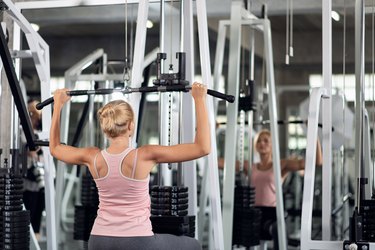
Even the slightest tweak in an exercise can drastically change the way it affects your body, and the straight-arm pulldown and lat pulldown exercises are no exception.
These two moves are slightly different in form and technique but can help you achieve different fitness goals. Learn more about these two moves, how to do them properly and how to incorporate them in your workout plan.
Video of the Day
Video of the Day
What Is the Straight-Arm Pulldown?
In the straight-arm pulldown, you stand upright in front of a cable machine and take hold of a short, straight bar attachment, explains Carolina Araujo, CPT, a New York-based strength coach. Gripping the handle with your palms facing down, you push the bar down as far as you can, keeping your elbows completely straight and knees slightly bent.
How to Do a Straight-Arm Pulldown
- Attach a short straight bar to a cable pulley high above your head.
- Hold each end of the bar and take a few steps back.
- Bend your knees slightly and hold the bar with straight arms, palms facing down.
- Keeping your elbows straight and back flat, draw the bar down until it's in line with your hips.
- Slowly reverse the motion, keeping your arms straight.
What Muscles Are Used in a Straight-Arm Pulldown?
Latissimus Dorsi
The lat pulldown (more on that below) and straight-arm pulldown are both shoulder extension exercises, which primarily work the latissimus dorsi, which is the largest muscle in your upper body. The muscle spans from your lower back to the middle of your spine and out to your shoulder, where it attaches.
Posterior Deltoid
The posterior deltoid, part of the big muscle that covers your shoulder, contributes in the lat pulldown and straight-arm pulldown. This muscle is in the back of the shoulder and helps pull your arm down and back during the movement.
Teres Major
Both exercises use a smaller muscle called the teres major, a small muscle that spans from the bottom of your shoulder blade to the side of your arm. It helps extend the shoulder, just like the lat and posterior deltoid, but it's the weakest muscle of the three.
Triceps
Your triceps, the muscles on the bottom of your arm, play a big part in the straight-arm pulldown.
What Is the Lat Pulldown?
The lat pulldown is usually performed on a pulldown machine or large cable system by grabbing each end of a long bar attachment, pulling the bar down to your chest (not to be confused with a behind-the-neck pulldown), Araujo says.
How to Do a Lat Pulldown
- Adjust the thigh supports so they press gently on top of your legs when seated. Attach the handle you want to use to the pulley hook at the top of the machine.
- Grab onto the bar and sit down with your feet flat on the floor. Your arms should be fully extended overhead and you should feel a stretch in your upper and middle back.
- Initiate the movement by pulling your shoulder blades down away from your ears. Drive your elbows down toward your ribs in a controlled manner. Lean back slightly (keep a neutral spine) without excessively arching your back.
- Keep pulling until the bar touches your chest, or until your elbows are touching your sides.
- Finish the movement by raising your arms back overhead in a controlled manner until they are fully extended and you feel a stretch in your upper and middle back.
What Muscles Are Used in a Lat Pulldown?
Lat pulldowns use all the same muscles as the straight-arm pull-down, however they do target a few extra areas.
Trapezius
As you pull the bar down, you use the lower part of your trapezius, which is a large muscle that connects to your neck, shoulder blades, spine and out to your shoulders.
Biceps
In the lat pulldown, your elbows bend as you pull down. The muscle that makes your elbows bend is your biceps, the muscle that sits on the front of your upper arm. This muscle is more active when you do a lat pulldown with your palms facing you.
Infraspinatus
Out of your four rotator cuff muscles, the one that contributes the most to the lat pulldown is the infraspinatus. This muscle sits on the back of your shoulder blades and stretches from the part closest to your spine all the way out into your shoulder.
Lat Pulldown vs. Straight-Arm Pulldown
Are Straight-Arm Pulldowns More Effective Than Lat Pulldowns?
One exercise isn't necessarily more effective than the other — it all depends on your personal fitness goals, Araujo says. For instance, lat pulldowns allow a wider grip, so if you're looking to improve your pull-ups, lat pulldowns are a better focus.
However, if building your overall back strength is the priority, you can (and probably should) incorporate both exercises in your workout routine.
"Having exercise variety can help target muscles from different angles, which can help you build more strength," Araujo says. "If you want to grow your muscles, keeping the variety can help you continue to build strength."
Typically, you can load more weight with a lat pulldown. Since you bend your arms during this move, your biceps help pull the bar down, which is a reason why you can probably lift more weight with this exercise.
A good lat pull-down alternative, straight-arm pulldowns also add some core-strengthening, as your trunk works to help maintain an upright position during this exercise, she explains.